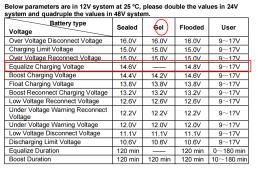Hello All
New to solar charging, and a new user here, and I may or may not have messed up with my purchases, but it's too late now, so I'll have to make the best of it, and I need some help in doing so.
I contacted EPEVER to ask why there is no AGM charge profile, for my new Tracer 2210-AN charge controller, and, in its absence, what should be the user settings for my AGM batteries? They replied, 'contact the battery manufacturer to confirm, as we cannot be responsible, etc, etc, but, the default profile for sealed should be fine for AGM batteries'.
I also contacted my battery supplier, who gave me the following advice, 'The only settings you need to alter, to suit your AGM batteries, would be to set bulk and absorption to 14.7V and to set float to 13.7V.'
Having spent the last few days reading here, and having found one or two relevant posts, I think I've gleaned that the above advice is largely correct, though I worry if the battery supplier's suggested bulk setting might be a tad high, having read a post in here about gassing? I also wonder if my float is a tad low, having a permanent, average, 6W load. (Nearly always almost exactly 6W), plus the default float value for 'sealed' on the controller is 13.8V anyway.
One further thing I spotted from my reading is that equalisation is not required for AGM, but even if I left that on, it only happens once per month, and the default value is only the same as the supplier's suggested value for bulk anyway, or boost, as I think EPEVER seem to call it, so I can't see how it would matter that much, if at all?
If my understanding is correct, I'm planning, 14.6V for boost, and 13.8V for float, (I read a post in here that 13.8V may help with "top off"). I'm also going to turn equalise off, even though it probably doesn't matter?
I'm also going to go with a slightly conservative LVC for the load output of 11.9V, compared to the default of 11.1V, because if I do end up dragging the batteries down, with my permanent 6W load, at night, perhaps after a few sunless days in a row, I'd rather them not go down as low as 11.1V before disconnecting my load. I'd rather lose my load supply early, than cause damage to the batteries, because turning off my few permanent devices, router, etc, wouldn't be a disaster, as long as they come back automatically, which they will, at the reconnect voltage.
Anyone here see anything wrong with my plan, for when I deploy next Tuesday?
New to solar charging, and a new user here, and I may or may not have messed up with my purchases, but it's too late now, so I'll have to make the best of it, and I need some help in doing so.
I contacted EPEVER to ask why there is no AGM charge profile, for my new Tracer 2210-AN charge controller, and, in its absence, what should be the user settings for my AGM batteries? They replied, 'contact the battery manufacturer to confirm, as we cannot be responsible, etc, etc, but, the default profile for sealed should be fine for AGM batteries'.
I also contacted my battery supplier, who gave me the following advice, 'The only settings you need to alter, to suit your AGM batteries, would be to set bulk and absorption to 14.7V and to set float to 13.7V.'
Having spent the last few days reading here, and having found one or two relevant posts, I think I've gleaned that the above advice is largely correct, though I worry if the battery supplier's suggested bulk setting might be a tad high, having read a post in here about gassing? I also wonder if my float is a tad low, having a permanent, average, 6W load. (Nearly always almost exactly 6W), plus the default float value for 'sealed' on the controller is 13.8V anyway.
One further thing I spotted from my reading is that equalisation is not required for AGM, but even if I left that on, it only happens once per month, and the default value is only the same as the supplier's suggested value for bulk anyway, or boost, as I think EPEVER seem to call it, so I can't see how it would matter that much, if at all?
If my understanding is correct, I'm planning, 14.6V for boost, and 13.8V for float, (I read a post in here that 13.8V may help with "top off"). I'm also going to turn equalise off, even though it probably doesn't matter?
I'm also going to go with a slightly conservative LVC for the load output of 11.9V, compared to the default of 11.1V, because if I do end up dragging the batteries down, with my permanent 6W load, at night, perhaps after a few sunless days in a row, I'd rather them not go down as low as 11.1V before disconnecting my load. I'd rather lose my load supply early, than cause damage to the batteries, because turning off my few permanent devices, router, etc, wouldn't be a disaster, as long as they come back automatically, which they will, at the reconnect voltage.
Anyone here see anything wrong with my plan, for when I deploy next Tuesday?




